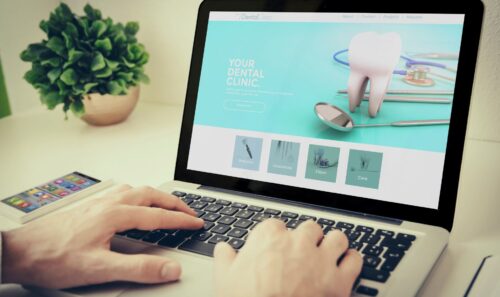Given that there are 3.5 billion smartphone users worldwide and UK adults spend at least 2 hours per day on their mobile phone it’s not surprising that we’ve seen our clients’ website viewing stats change over the past five years (for example one client has gone from 23% of viewers using smartphones in 2016 to 57% using smartphones in 2021 and for one client that percentage is over 85%). It makes sense to give priority to mobile led design for your website when so many people are using their mobile phones to navigate the web.
What is mobile first design?
It’s a strategy of designing your dental website for the smallest screen first and then moving towards larger screens in order to provide the correct user experience to each type of device.
Starting with mobile first means that the hierarchy of content and functionality is prioritised due to the limited space available on mobile which all too often has been an afterthought in the design process in the past.
What are the benefits of mobile first design?
Improve your SEO results – Google ranks for mobile-friendliness because a site built for desktop can be difficult to view and use on a mobile device. A non-mobile-friendly site requires users to pinch or zoom in order to read the content. Users find this a frustrating experience and are likely to abandon the site. Alternatively, the mobile-friendly version is readable and immediately usable.
Increase your conversions – mobile first design means focussing on the essential information and prioritising content over navigation. By removing anything unnecessary the user can get straight to the point. By serving the information the user is looking for quicker the user experience is improved which should lead to higher conversion rates which makes good business sense.
How do I know if my website is mobile-friendly?
Google created a tool that can analyse any URL, try it out.
How do I design mobile first?
The main things to prioritise when designing your dental website for mobile are:
1. Small screen friendly – your users need to be able to read your content on smaller screens which means they’re more accessible for people with limited vision.
2. Hierarchy of information – prioritise the content that users are looking for as soon as possible on your page also meaning your content is accessible for people with cognitive disabilities. For example:
- Put your brand logo and name at the top of the design to orientate the user. Serve the information that users want to see above anything else without the need to scroll through the page.
- Keep easy to reach navigation buttons at the top of the page that remain in place when scrolling so users can find additional information. As well as a standard burger menu it’s useful to keep a CONTACT US / BOOK NOW / PHONE NUMBER button visible to help conversions.
- Avoid content users don’t want to see such as pop ups and adverts. It’s frustrating when you can’t close a pop up on your phone and will cause them to leave the site. Add clear and relevant calls to action as high up the page as possible to improve conversion rates.
Get in touch if you want us to evaluate your dental website.








